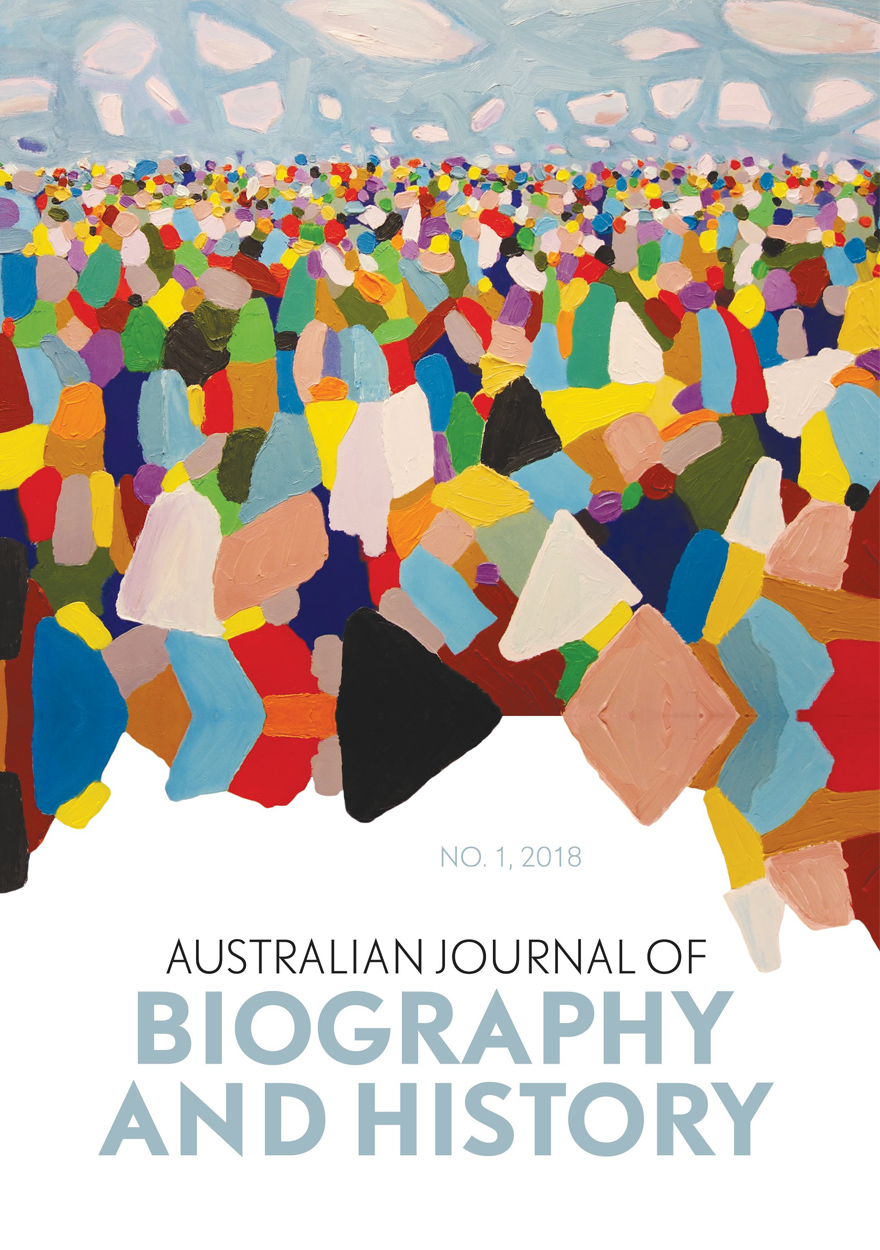Australian Journal of Biography and History
The Australian Journal of Biography and History is an initiative of the National Centre of Biography (NCB) in the Research School of Social Sciences at The Australian National University. The NCB was established in 2008 to extend the work of the Australian Dictionary of Biography and to serve as a focus for the study of life writing in Australia, supporting innovative research and writing to the highest standards in the field, nationally and internationally. The Australian Journal of Biography and History seeks to promote the study of biography in Australia. Articles that appear in the journal are lively, engaging and provocative, and are intended to appeal to the current popular and scholarly interest in biography, memoir and autobiography. They recount interesting and telling life stories and engage critically with issues and problems in historiography and life writing.
The journal publishes peer-reviewed articles on Australian historical biography, including biographical studies, studies relating to theory and methodology, and the associated genres of autobiography, life writing, memoir, collective biography and prosopography. We are especially interested in articles that explore the way in which biography and its associated genres can illuminate themes in Australian history, including women in Australian society, family history, transnational networks and mobilities, and Indigenous history.
Ownership and management
The Australian Journal of Biography and History is an initiative of the National Centre of Biography (NCB) in the Research School of Social Sciences at The Australian National University, and ANU Press publishes a free electronic version and a print-on-demand hard copy of the journal.
Publishing schedule
The Australian Journal of Biography and History is published biannually.
Access
Fully open-access electronic publication with a print-on-demand hard copy option.
Copyright and licensing
All issues published from Volume 4(1) onwards are published under Creative Commons Attribution-NonCommercial-NoDerivatives 4.0 International (CC BY-NC-ND 4.0). Issues published previous to this are under a standard copyright licence.
Authors retain copyright of articles published in this journal.
Revenue sources
The Australian Journal of Biography and History is supported by The Australian National University.
Author fees
There are no fees charged to authors for publishing work in the Australian Journal of Biography and History. Authors are, however, expected to pay where required any fees arising from using copyright works within their articles.
Peer review process
All articles submitted to this journal undergo a double-blind peer-review process. The peer-review process is arranged by the Journal Editor, who then decides upon publication, amendment or rejection. Manuscripts that undergo amendment may be subject to further review by the Journal Editor or an external reviewer.
Process for identification of and dealing with allegations of research misconduct
If the Journal Editor receives a credible allegation of misconduct by an author, reviewer, or editor, then they have a duty to investigate the matter with ANU Press, in consultation with relevant Associate Editors and members of the Editorial Board. If the claim is substantiated, the Editor will follow the guidelines set out by COPE for retracting the article in question.
If the Journal Editor receives convincing evidence that the main substance or conclusions of an article published in the journal are incorrect, then, in consultation with the journal’s Associate Editors and/or Editorial Board and ANU Press, the Journal Editor will ensure the publication of an appropriate notice of correction.
Publication ethics
The journal follows the guidelines set out by the Committee on Publication Ethics (COPE): https://publicationethics.org/resources/guidelines
Duties/responsibilities of authors
Authors are responsible for providing:
- original submissions of articles, fully referenced according to the journal’s guidelines, which follow Chicago style with Australian spelling. For more details on Chicago style, please see: www.chicagomanualofstyle.org/tools_citationguide.html (incorrect referencing will mean that articles may not be considered for publication)
- payment for all costs and copyright permissions of all images
- filling out journal copyright and author’s declaration forms, which will be provided to authors once an article is accepted for publication
- acknowledgement of any material that has been previously published • acknowledging any external research grants/conflicts of interest.
Duties/responsibilities of editors
- The Editor of Australian Journal of Biography and History may reject a submitted manuscript without formal peer review if he/she considers it to be inappropriate for the journal and outside its scope.
- The Editor reserves the right to have final decisions on the content of all journal issues.
- The Editor keeps the peer-review process confidential.
- The Editor will make all reasonable effort to process submissions on time.
- The Editor will delegate the peer review of any original self-authored research article to a member of the editorial or advisory board as appropriate.
Duties/responsibilities of reviewers
Reviewers are responsible for ensuring:
- timely production of reviews
- fair and unbiased assessment
- they follow the guidelines for review document of the journal, which will be provided to the reviewer once they accept the position.
In addition, reviewers will keep in mind the following guidelines for the review: https://publicationethics.org/files/Ethical_Guidelines_For_Peer_Reviewers_2.pdf
Guidelines for guest editors
An Australian Journal of Biography and History guest editor is responsible for the intellectual content of that particular issue and the papers that comprise it. This includes not only securing articles from authors, but also managing the reviewing—that is, arranging for each paper to be reviewed (by at least two independent reviewers) and working with authors to make the necessary revisions. Guest editors take responsibility for liaison with contributing authors and peer reviewers. Please note that the journal only publishes articles that constitute an original piece of research.
An Australian Journal of Biography and History guest editor is also responsible to ensure that the authors follow the guidelines provided in the submission requirements: Articles should be in the range of 5,000 to 8,000 words (excluding footnotes), although longer submissions may be considered after consultation with the Editor. They should be accompanied by an abstract of no more than 200 words. A guest editor will write an overview editorial. Referencing should be done using the Chicago Manual of Style and footnotes, which follow Australian spelling.
If at any point in the process the guest editor and authors have questions, they should immediately contact the AJBH Editor, Dr Samuel Furphy: Samuel.Furphy@anu.edu.au.
Once published, each guest editor will receive 2 complimentary hardcopies of the special number.
Editorial team
- Editor: Samuel Furphy
- Copyeditor: Rani Kerin
Editorial Board
- David Carment (Charles Darwin University)
- Libby Connors (University of Southern Queensland)
- Karen Fox (ANU)
- Sam Furphy (ANU)
- Lawrence Goldman (St Peter’s College, University of Oxford)
- Catherine Kevin (Flinders University)
- Lenore Layman (University of Western Australia)
- Doug Munro (University of Queensland)
- Melanie Nolan (ANU)
- Carolyn Rasmussen (University of Melbourne)
- Hans Renders (University of Groningen)
- Sophie Scott-Brown (University of East Anglia)
Contact Details
All correspondence should be addressed to the Editor, Australian Journal of Biography and History, National Centre of Biography, School of History, RSSS, 146 Ellery Crescent, Acton, ANU, 2601, or Samuel.Furphy@anu.edu.au.
Please send article submissions or abstracts to the Editor, Dr Samuel Furphy, National Centre of Biography, The Australian National University. Email: Samuel.Furphy@anu.edu.au. Articles should be in the range of 5,000 to 8,000 words (excluding footnotes), although longer submissions may be considered after consultation with the Editor.
Style and referencing: please use footnotes in Chicago style, and follow Australian spelling.

Australian Journal of Biography and History: No. 9, 2025 »
Special Issue: Oceania Lives

Australian Journal of Biography and History: No. 8, 2024 »

Australian Journal of Biography and History: No. 7, 2023 »
Special Issue: Convict Lives

Australian Journal of Biography and History: No. 6, 2022 »

Australian Journal of Biography and History: No. 5, 2021 »

Australian Journal of Biography and History: No. 4, 2020 »

Australian Journal of Biography and History: No. 3, 2020 »

Australian Journal of Biography and History: No. 2, 2019 »




